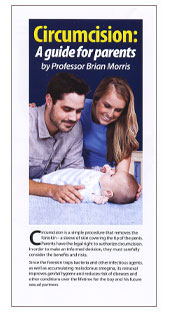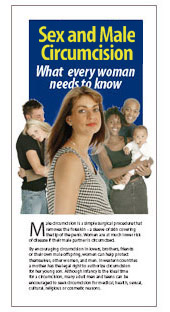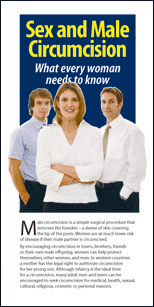Herpes Simplex Virus Type 2 in Women
As described for HPV, a history of sexual intercourse with an uncircumcised man (ever) was reported in 2003 to be a risk factor for herpes simplex virus type 2 (HSV-2) infection in women [Cherpes et al., 2003]. After multivariate logistic regression analysis, odds ratio was 2.2 (95% CI 1.4-3.6) [Cherpes et al., 2003]. This study was conducted in Pittsburgh, Pennsylvania amongst 1,207 women aged 18-30 years whose overall HSV-2 seroprevalence rate was 25%.
A study in Uganda found no difference, however, although most women had been infected with HSV-2 prior to commencement of the trial in which half the men had been randomized to receive circumcision and the other half had not, meaning that HSV-2 detected in swabs from these women represented mostly reactivation of an existing infection [Brankin et al., 2009].
HSV-2 prevalence was lower in 9 countries in which MC prevalence was >80% than it was in 10 countries in which MC was < 20% (30.1% vs. 42.9%, respectively; P >0.05) [Drain et al. 2006]. A study in India found an HSV-2 prevalence of 1.7% among women with circumcised spouses compared with 9.2% among women with uncircumcised spouses (OR = 5.7; 95% CI 1.4–23.4; P=0.01) [Borkakoty et al., 2010]. Similarly, a South African study of 4,766 women aged 15–49 years found that having a circumcised male partner was associated with lower HSV-2 prevalence in both younger women (49% vs. 62%; P < 0.01) and older women (83% vs. 86%; P=0.04) [Davis et al., 2017]. In that study, older women with circumcised male partners were less likely to have ever had an STI (7% vs. 11%; P<0.01).
Among 8,953 women in Kenya, those with circumcised partners had an HSV-2 prevalence of 39.4% compared to 77.4% in women with uncircumcised partners (P<0.001) [Mugo et al., 2011]. Risk of HSV-2 infection was 7.5 times higher among HIV-positive vs. HIV-negative women in that study. However, a study involving 14 sites in 7 sub-Saharan African countries found that MC provided negligible protection against HSV-2 infection among female partners (PRR = 0.94; P=0.49) [Mujugira et al., 2011].
A nonsignificant 15% risk reduction was found in the female partners of 368 circumcised men in a RCT in Uganda [Tobian et al., 2012]. In a Kenyan study, there was no difference in HSV-2-related genital ulcers between 14 women with circumcised and 14 women with uncircumcised partners [Mehta et al., 2017].
In summary, there is evidence from large observational studies, but not from trial data and some other studies, to suggest that male circumcision may reduce HSV-2 infection and prevalence in women. For more see systematic reviews [Grund et al., 2017; Morris et al., 2019b].



